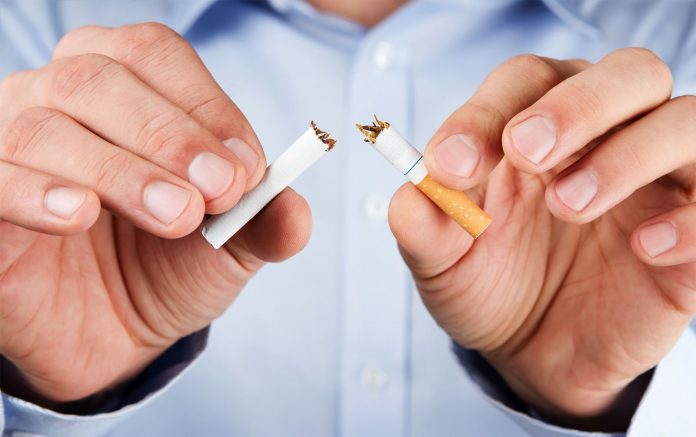Posted: April 2017
By Cynthia L. Kryder, MS
Tobacco exposure remains one of the leading preventable causes of premature disease and death in the United States and abroad. Around the world, 6 million people die each year as a result of tobacco exposure, including 480,000 people in the United States. The global costs of smoking due to health problems and lost productivity are staggering and have been estimated to exceed USD$1 trillion annually.1
Not only is smoking a risk factor for lung cancer, the adverse effects of smoking continue even after a cancer diagnosis. Smoking and tobacco-related products promote more aggressive tumors through increased proliferation, angiogenesis, migration, invasion, and resistance to cytotoxic therapy, and they cause adverse outcomes in patients with cancer through increased overall mortality, cancer- specific mortality, risk for developing a second primary cancer, and strong associations with increased toxicity from cancer treatment.2
In an effort to improve population health, the Finnish government aims to make the country tobacco-free by 2030. With the ambitious goal of having fewer than 2% of adults using tobacco in any form by 2040, Finland enacted new measures in January 2017 to help its residents kick the habit.
Finland already had a reputation for being tough on smokers. As a pioneer in smoking-reduction efforts, Finland first introduced the Tobacco Act in 1976, which included measures to reduce the use of tobacco products. Initial efforts involved banning advertising and retail displays of nicotine products. Smokefree workplaces were implemented in the mid-1990s, and smoking in bars and restaurants was banned in 2007.3 These measures have deterred smoking to some degree. According to statistics reported by Finland’s National Institute for Health and Welfare, cigarette smoking has steadily declined over the past 2 decades, at least among men. Still, in 2014 the prevalence of daily smoking was 17% for men and 14% for women, which represents 875,000 daily or occasional smokers among the 15- to 84-year-old population.3
Among Finland’s latest efforts is legislation that increases the cost to retailers, who will likely pass these costs on to customers. Vendors who want to sell tobacco products are now required to pay a one-time licensing fee plus an annual surveillance fee that covers the cost of surveillance officers who ensure compliance. Surveillance fees, which are set by individual municipalities rather than by the state, are calculated per cashier and can cost as much as €500 (USD$536) annually per checkout.4 Such fees may make it unprofitable for retailers to sell tobacco products. A ban on price rebates for tobacco products, tobacco substitutes, smoking accessories, tobacco imitations, electronic cigarettes, and nicotine-containing liquids may present further financial barriers for smokers.
The aim of Tobacco-Free Finland is ambitious, but obtainable. More and more emphasis is put ….into prevention of initiation of the use of tobacco products. In our opinion the main challenge is to be efficient in systematically offering enough help and support to our smoking patients in quitting smoking…
—Annamari Rouhos, MD, PhD, Helsinki University Hospital Heart and Lung Center and the Finnish Respiratory Society in the working group of Tobacco-Free Finland 2030 network
—Aija Knuuttila, MD, PhD, Helsinki University Hospital Tobacco-Free Finland from page 1 Many of the scientific presentations later made at larger meetings around the globe are first discussed at this event.
Finland also has moved from regulating tobacco use in public spaces into the private domain. Recent measures include a ban on smoking in private cars if passengers under the age of 15 years are present and the extension of smokefree policies to residential properties. For example, Finland now permits housing companies to apply for a ban prohibiting residents from smoking on the balconies of individual apartments, if the smoke spreads from the private living space into other areas.4
In addition to getting smokers to give up the habit, Finland wants to reduce the number of people who start smoking in the first place by decreasing its appeal and availability. Consequently, it has put in place restrictions on the purchase of products that imitate tobacco or cigarettes, such as cigarette- or pipe-shaped candy. E-cigarettes also are strictly regulated; they are banned in venues where smoking is prohibited, regardless of whether or not they contain nicotine, and they may not be formulated with any flavors. Likewise, sale of smokeless tobacco products is prohibited.4
As the first country in the world to set the goal of ending the use of tobacco and other nicotine-containing products, Finland serves as a model for other countries seeking to take an aggressive approach to the elimination of products that are harmful to humans and cause addiction. Finland’s multifaceted tobacco-control program should help to reduce tobacco-related disease and death.✦
References
1. US National Cancer Institute and World Health Organization. The Economics of Tobacco and Tobacco Control. National Cancer Institute Tobacco Control Monograph 21. NIH Publication No. 16-CA-8029A. Bethesda, MD: US Department of Health and Human Services, National Institutes of Health, National Cancer Institute; and Geneva, CH: World Health Organization; 2016. http://cancercontrol.cancer.gov/brp/tcrb/monographs/21/ index.html. Accessed March 23, 2017.
2. US Department of Health and Human Services. The Health Consequences of Smoking—50 Years of Progress: A Report of the Surgeon General. Atlanta, GA: US Department of Health and Human Services, Centers for Disease Control and Prevention, National Center for Chronic Disease Prevention and Health Promotion, Office on Smoking and Health; 2014. https://www.surgeongeneral.gov/library/reports/50-years-of-progress/. Accessed March 21, 2017.
3. National Institute for Health and Welfare [website]. Smoking in Finland. Updated 5 September 2016. https:// www.thl.fi/en/web/alcohol-tobacco-and-addictions/tobacco/smoking-in-finland. Accessed March 21, 2017.
4. Ministry of Social Affairs and Health, Finland. Tobacco Act











